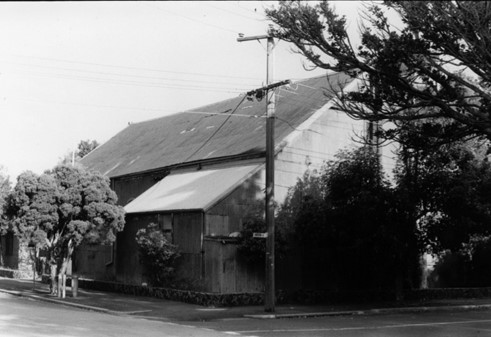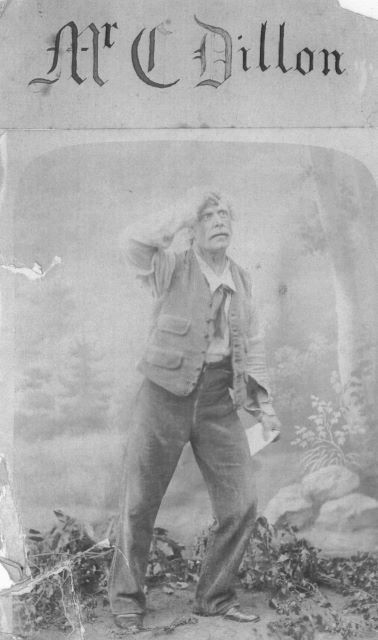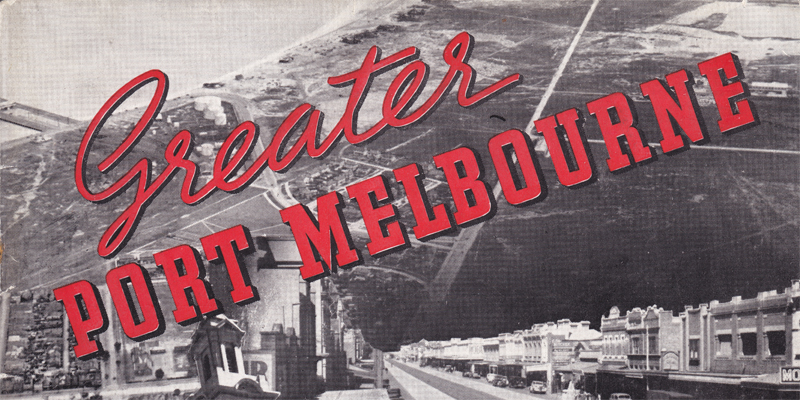The Dillon Family
by Ray Jelley
The man directly responsible for the existence of the Excelsior Hall was Charles Dillon (at times known as Chas. Dillon Jnr.), the son of Charles Middlemiss Dillon and Catherine née Wallace.[1] The history of the building and the family’s history were inextricably linked.
The place to start this journey is some distance from the Excelsior Hall in Bridge Street. It is in Ireland where Charles Middlemiss Dillon’s father, Bartholomew, was born in about 1801. Bartholomew left Ireland and travelled to Yorkshire where he spent the rest of his life, marrying Eleanor Middlemiss in November 1831 and having six children. The first born was Charles Middlemiss. Bartholomew was a Master Corset Maker. His two unmarried daughters, Emma, born in 1834 and Margareta, born in 1843, continued the business as ‘Ladies Outfitters’, after their father died in 1867, until they both retired between 1891 and 1901.
The Dillon family in Beechworth
Charles Dillon Jnr. was Charles Middlemiss Dillon’s second child of the seven born to him and his wife Catherine Wallace. He was born in 1857 in Beechworth where Charles was trying his luck in the goldfields. The couple’s first four children were born in Beechworth, after they arrived there in about July 1855. Catherine and her elder sister Bridget, aged seventeen and eighteen respectively, had arrived in Sydney in 1849 on board the Lady Peel as assisted migrants. They were both listed as ‘Nursemaids’ on the ship’s manifest and were both indentured to work for their sponsors for two years and one year respectively.[2] During his time seeking gold Charles became a member of the local mining board and was instrumental in establishing a school at Stanley. There are numerous mentions of him in the Ovens and Murray Advertiser from 1857 to 1861. In 1857, Charles took the chair at a meeting of miners of the Nine-Mile goldfield to protest the surveyor general’s proposal to survey the area prior to it being offered for sale. The miners were adamant that the area was auriferous, and alienation would disrupt their mining activities.[3] Charles was also involved in disputes over water rights and clashed with others in the area on several occasions. The tone of some of the articles that mention Charles indicate that he was forthright and willing to take on politicians over the Land and Goldfield Bill which was proposed in 1857 and passed as An Act for amending the Laws Relative to the Gold Fields in November 1857.[4] Charles, in company with three other miners, expended the then huge sum of £1100 (about $117,000 in 2021) in 1860/61 to build a tailrace over a mile long to take water to their workings in the Europa Gully near Stanley.[5] It is unclear how successful they were working over the old and abandoned ground in the head of the gully.
From the Goldfields to Sandridge
Not long after Charles was granted an allotment in Stanley in 1861, which he didn’t take up, the family moved to Sandridge. Charles took up working as a cabman, which suggests that while he had some success, it was less than expected. An article in the Argus of 10 November 1863 reported that ‘Charles Dillon, a cabman, charged with insulting behaviour at the Hobson’s Bay Railway Station’.[6] The directories have no mention of Charles Dillon until the 1868 edition which leads me to believe the family were living as boarders until he became the head of the household when living in Rouse Street between Johnston Street and the lagoon in the house closest to the lagoon. The family lived in this house until 1879 when they moved to a house on the east side of Stokes Street between Rouse and Graham Streets. While the family were living in Rouse Street the last three girls were born, making a family of five girls and one boy as Kate, who had been born in 1861 while Charles and family were in the Beechworth area, died on 17 October 1865.
There are several mentions of Charles Dillon the cabman throughout the late 1860s and 1870s that indicate that his forthright manner remained. He was charged with using indecent language, using threatening language to a policeman and illegally soliciting for fares on the Hobson’s Bay Railway Company premises. He was also charged with not having his horses under control on three separate occasions. In 1878, Charles was made insolvent over debts that he could not pay. The causes were stated as ‘[s]ickness of self and family, dulness [sic] of business and pressure of creditors’.[7] However, he continued to work as a cabman despite his poor health which finally resulted in his death in 1894. His wife Catherine had died in 1885.
In 1882, when the younger Charles Dillon was twenty-five, he married the twenty-year-old Anna Christina Cecilia Holm. In 1883 their first child, Cyril was born. He was followed by another four children: Claude in 1885, Elsie in 1887, Charles in 1889 and Christina Cecilia in 1891. Elsie was the only one to die as an infant in 1888. After their marriage Charles and Anna took up residence at 50 Princes Street between Rouse and Graham Streets quite close to where the older Charles and Catherine lived in Stokes Street. Between 1890 and 1894 Charles, the younger, and his family moved to the house at 56 Clark Street. The number changes over the years resulted in the house now having the number 68 and it is situated on the east side of Clark Street on the corner of Clark and Nelson Streets. Charles lived here for the rest of his life. It’s not clear exactly when Charles began working for Swallow and Ariell, or in what capacity, but his obituary in 1929 described him as having ‘spent his working life in the service of Swallow and Ariell Ltd., for whom he was, for many years, a commercial traveller in the suburbs’.[8]
Excelsior Hall
In the Standard on 29 November 1884 was an announcement that in many ways began the story of how the name Dillon became associated with the social well-being of the people of Port Melbourne:
“Many of our readers will be agreeably surprised to hear that a similar institution [The Excelsior Club] now exists in Port Melbourne. The work of originating this excellent movement has been carried on so quietly and unostentatiously that few of the residents are even aware of its propinquity. To Messrs. Peter Grut, Chas. Dillon and D. Turnbull belong the honour of what will in future be known as the Port Melbourne Excelsior Club.”[9]
From this first mention of the Excelsior Club the Standard continued to report on the activities of the club until, due to financial pressure, it ceased operating in about the middle of 1897. The club was established to take the youths off the streets of Port Melbourne where they were contributing to hooliganism and causing much harm to buildings and the populace by their actions. It proved to be a resounding success for the time that the club existed. Charles Dillon’s name appears in almost every article about the club and describe his successful efforts to have the Excelsior Hall built in 1886. In addition, it highlights Charles’ love of Shakespeare and amateur dramatics for which he was acclaimed on many occasions.
Despite the collapse of the Excelsior Club, Charles continued to use the hall at various times for his recitations. Charles also became a dedicated volunteer with the Port Melbourne Swimming Club and the Athletics Club which both used the hall for meetings during the early 1900s. The Excelsior Hall became a valuable resource for many of the residents of Port Melbourne.
It was not surprising that during my research of Charles Dillon and his family I came across many instances of Charles and his family mixing with well-known names associated with the history of Port Melbourne: Crichton, Crockford, Derham, Grut, Freame, Rendall, Swallow, and Salmon to name just a few.
The next generation of the Dillon family
Charles and Anna’s children were equally successful in their lives. Cyril became a noted artist and etcher who was commissioned by Dame Nellie Melba to do a series of etchings of her home, Coombe Cottage in Coldstream. As a mark of her deep friendship for Cyril, before she died in 1931, she left in his care five of the etchings that he had done for her which were to be passed on to each of Cyril’s five sons when they married.[10]
Claude, their second son, was dux of the Nott Street school in 1899 and in 1900 won first prize in the South Melbourne branch St John’s Ambulance award. Claude was also active in the Athletics Club and was instructing in gymnastics in 1904 when he was nineteen. When a Port Melbourne Swimming Club was formed in 1911 Claude was a member of the organising committee along with other prominent members of the Port Melbourne community. He also married Elsa Catherine Barker in the same year. In 1915 Claude was appointed secretary of the Shipowners’ Federation of Australasia, Sydney branch and his family of three moved to Sydney.[11] Claude occupied this position and others associated with sea transport until 1950 when he retired.[12] Claude and Elsa had two sons Clive Barker born in 1913 and Edgar Ernest Charles born in 1915. Both joined the Royal Australian Navy during World War Two.
Charles and Anna’s fourth child named Charles was born in 1889. Like his father and elder brother Charles was a keen sportsman who played cricket with the Port Melbourne Cricket Club, was an accomplished runner, did ju jitsu and was a member of the Port Melbourne Swimming Club life savers. He married Evelyn Mary Stuart Harris in 1914 and they had at least three children, Evelyn Eunice in 1916, Charles Matthew in 1918 and Christiana Joyce in 1921. Tragically, Charles Matthew died when he was just one day old.
The youngest child for Charles and Anna was Christiana Cecilia born in 1891. She became a dressmaker and in 1921 married Sydney Leverett. They had at least one child, Geoffrey Richard born in 1922.
The drive and dedication of Charles Dillon throughout his life contributing to society was typical of the citizens of the Borough who made many sacrifices to ensure a healthy and vibrant community in which people could live safely and happily. The commitment and strength Charles and members of his family demonstrated individually were characteristic of their Dillon ancestors.
The Port Melbourne Council took over the hall in 1901 and later it became the site of the Port Melbourne RSL. It was finally purchased for conversion to residential dwellings in 2003, with the renovations being completed in 2004.
[1] ‘Mr Charles Dillon Dies, Amateur Actor of Old School,’ Herald, June 13, 1929, p. 2.
[2] Image: Lady Peel arrived in Sydney 3 July 1849; Image: History of the Dillon Family, courtesy of Sue Hamilton.
[3] ‘Proposed Township at the Nine-Mile,’ Ovens and Murray Advertiser, April 23, 1857, p. 2.
[4] ‘Land and Gold Field’s Bill,’ Ovens and Murray Advertiser, July 25, 1857, p. 2.
[5] ‘Mining Surveyors’ Report, Beechworth Mining District,’ Ovens and Murray Advertiser, October 6, 1859, p. 3.
[6] ‘Police, City Court,’ Argus, November 10, 1863, p. 6.
[7] ‘Local Insolvents,’ Record and Emerald Hill and Sandridge Advertiser, October 18, 1878, p. 3.
[8] ‘Mr Charles Dillon Dies.’
[9] ‘Excelsior Club at Port Melbourne,’ Standard, November 29, 1884, p. 3.
[10] ‘Of Personal Interest, Gift from Melba,’ Age, February 28, 1945, p. 4.
[11] ‘Shipowners’ Secretary,’ Port Melbourne Standard, June 5, 1915, p. 2.
[12] ‘Shipping Man is to Retire,’ Sydney Morning Herald, March 23, 1950, p. 2.
You may be interested in further material on Excelsior Hall
The Story of Excelsior Hall designed and written by Pat Grainger, available from the shop for $5
Returned Sailors’ and Soldiers’ Imperial League of Australia, the forerunner of the RSL, established in 1916
Excelsior Hall’s use as an inhalarium in the Flu epidemic of 1919




2 Comments
Brandon Dillon
Thank you for the information it was awesome to find out.
Jill Wardrop
Thank you for putting together such a fascinating history. May I suggest a minor amendment? Claude and Elsa also had a daughter, my mother, Peggy Christiana Dillon, born on 15 August 1922 after they moved to Sydney.